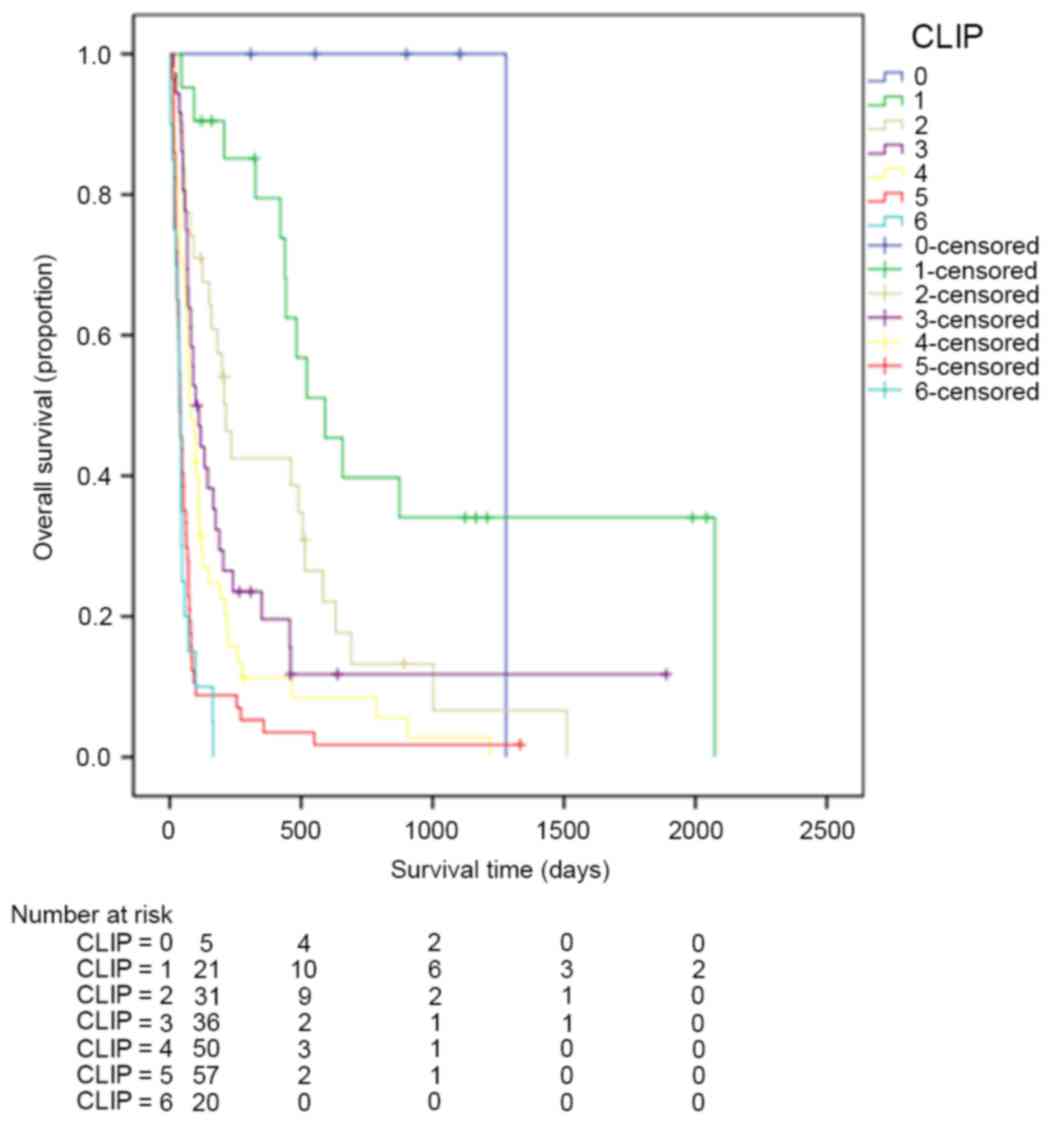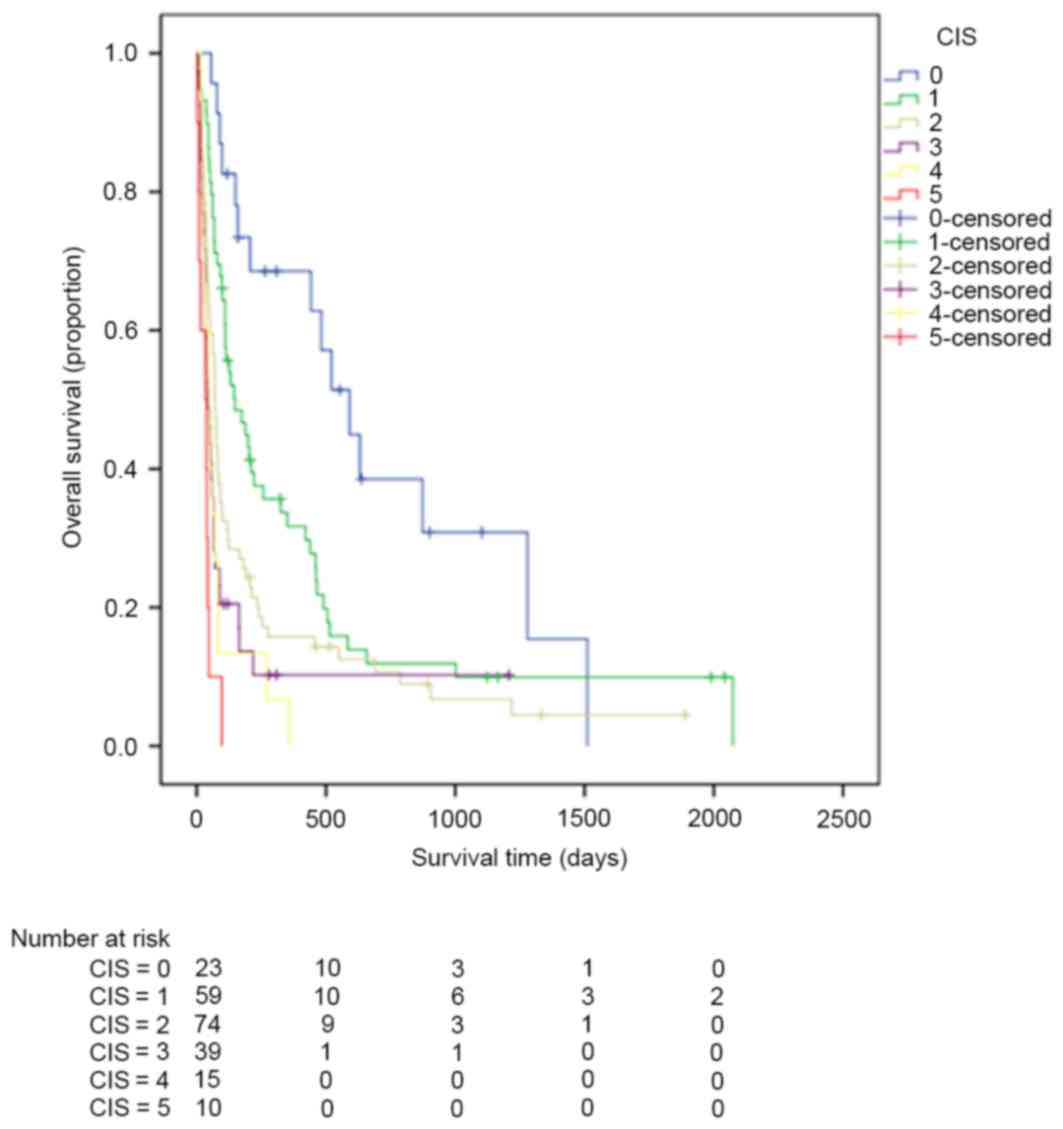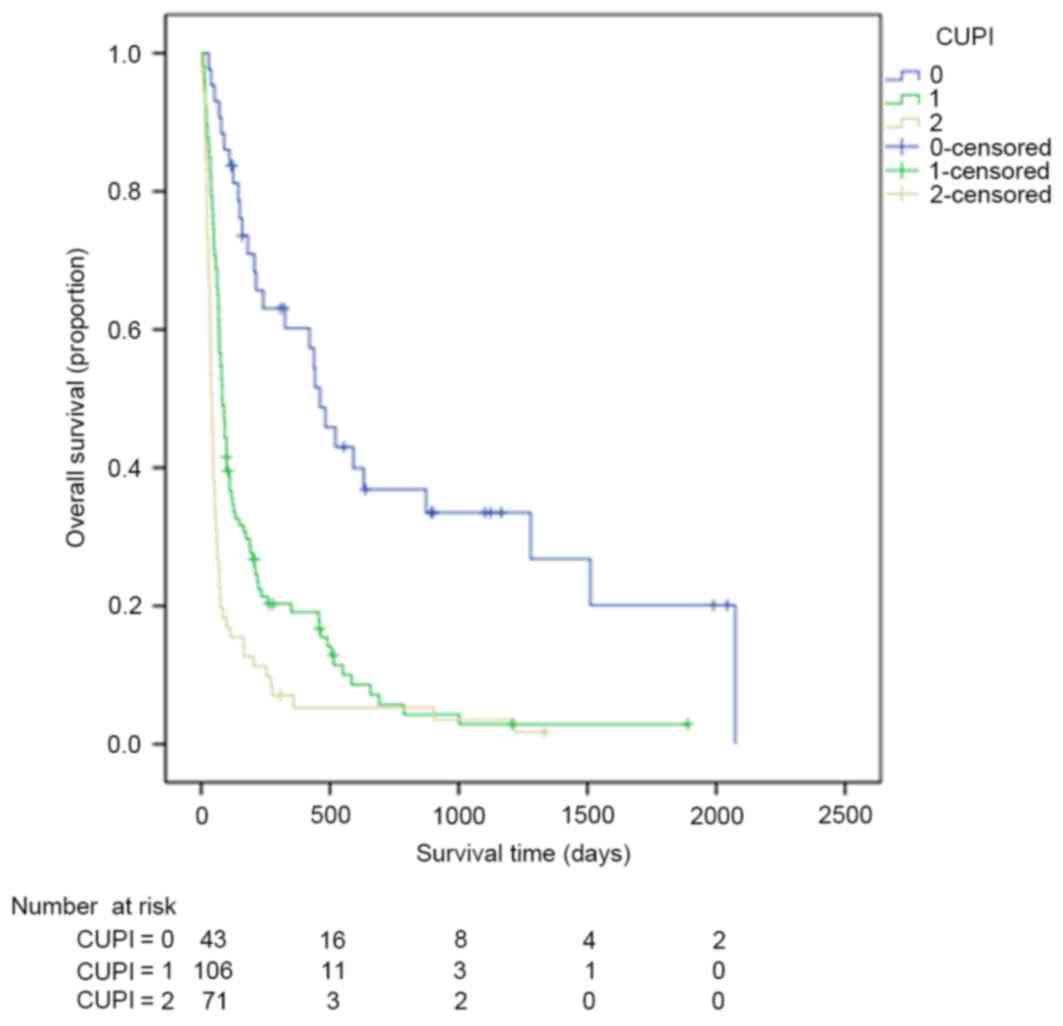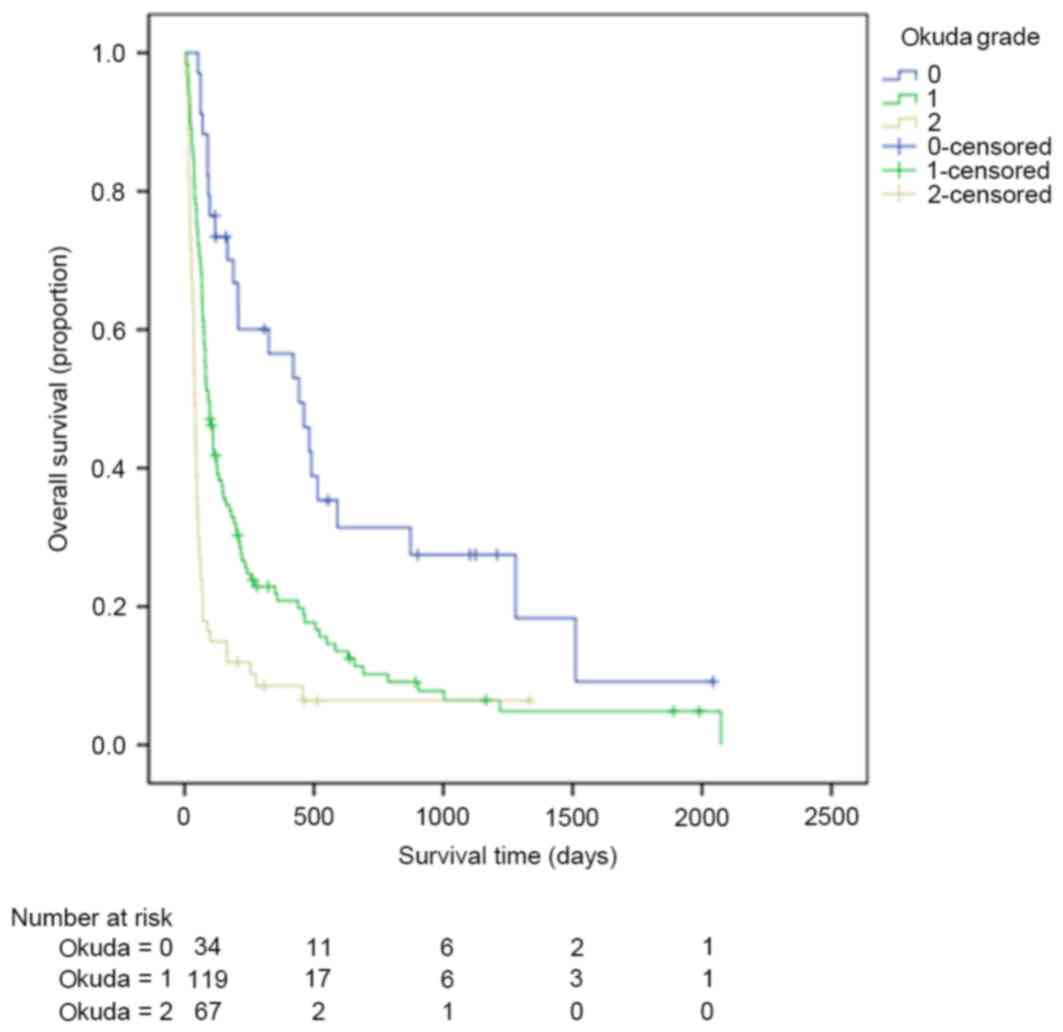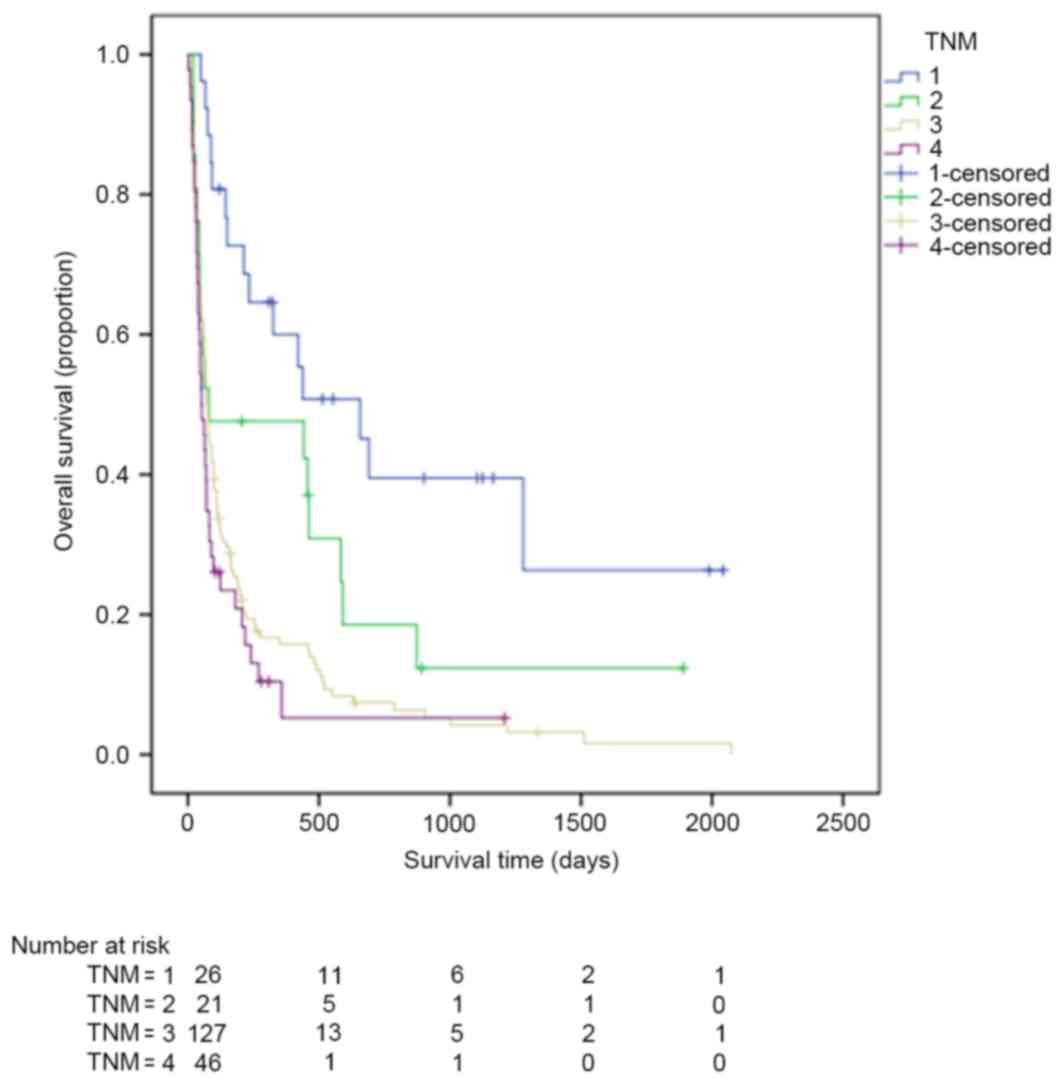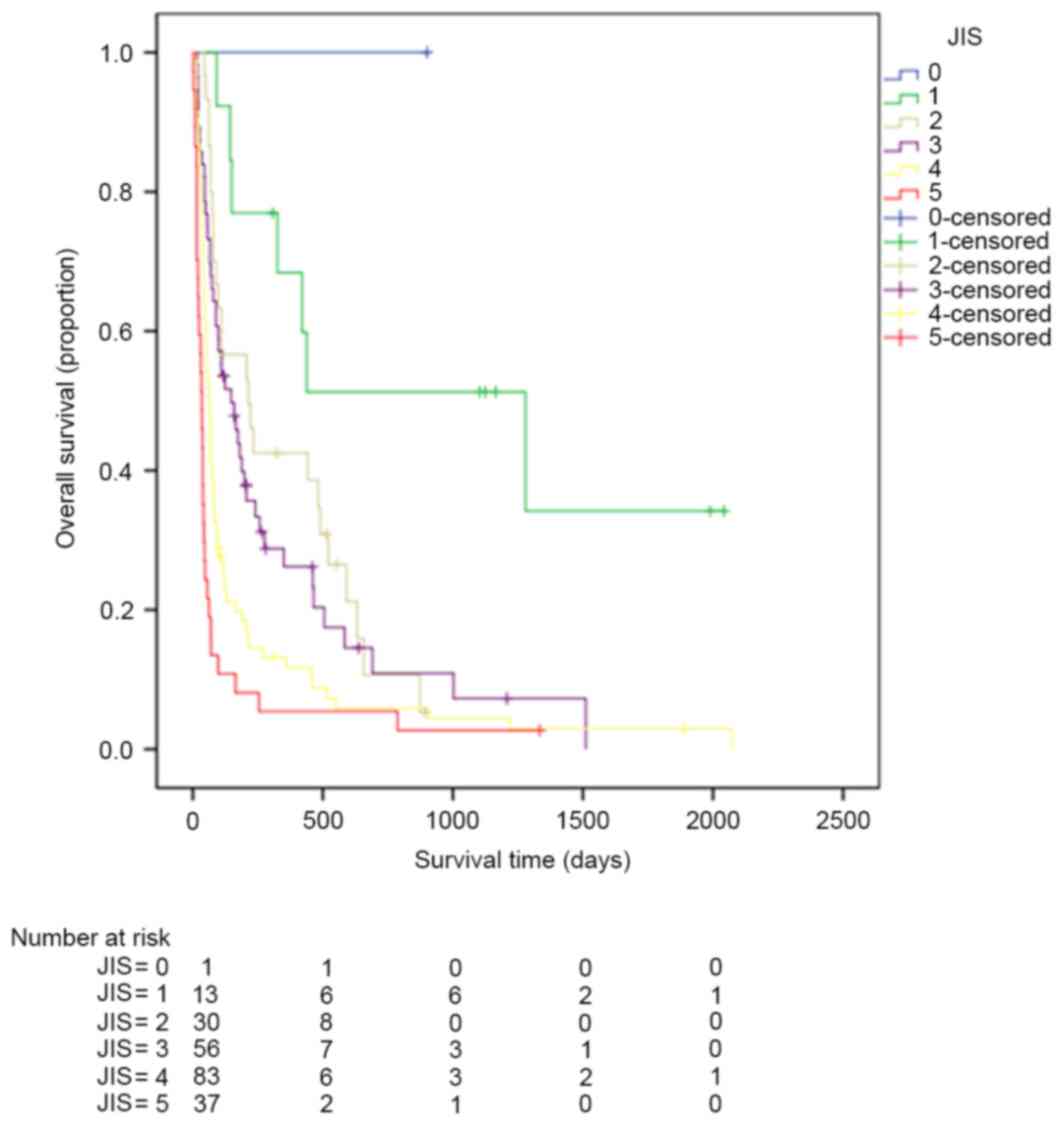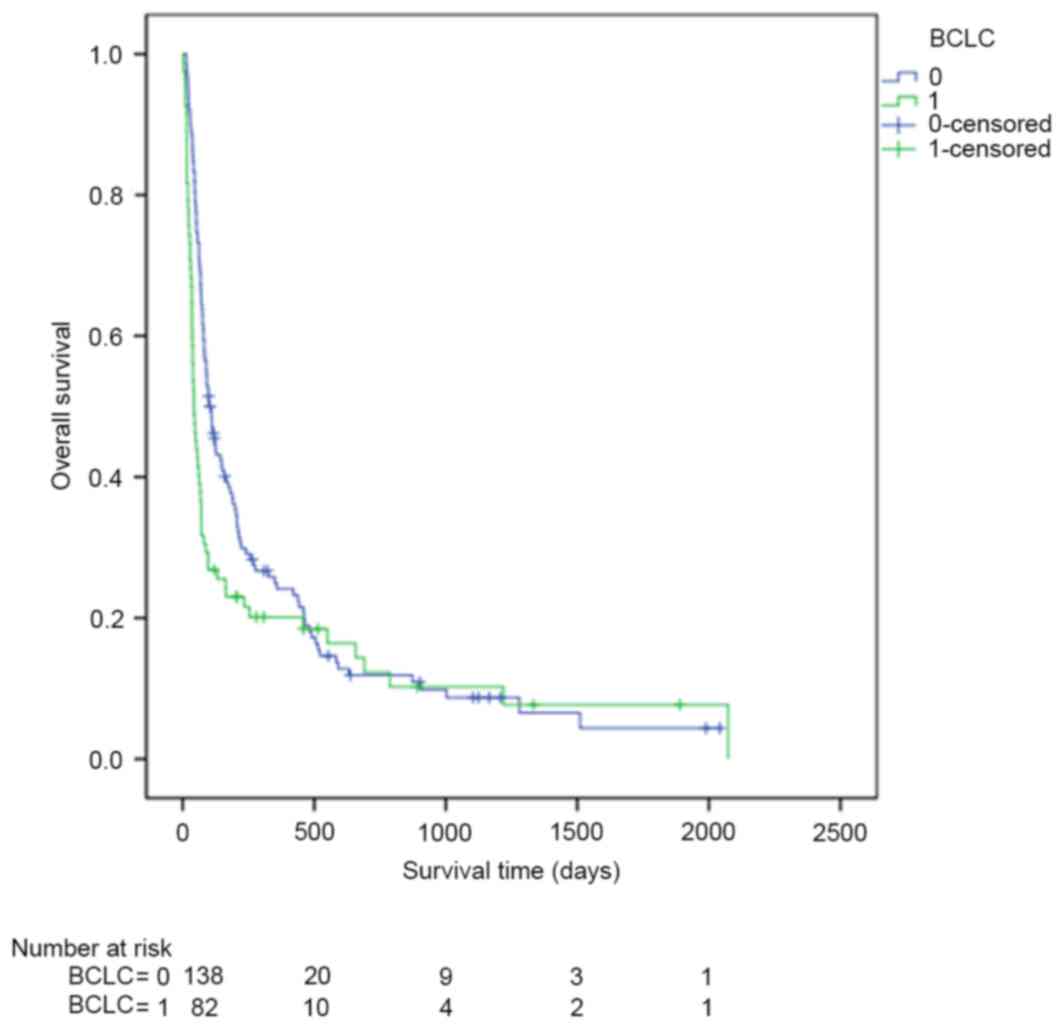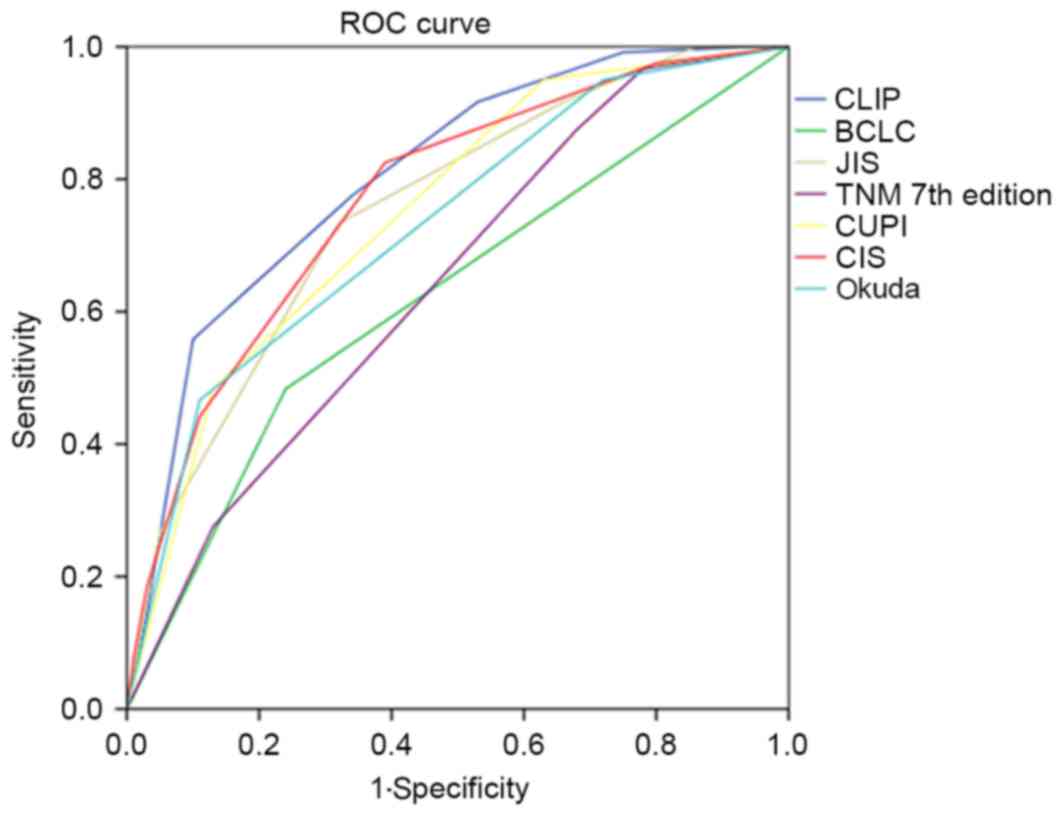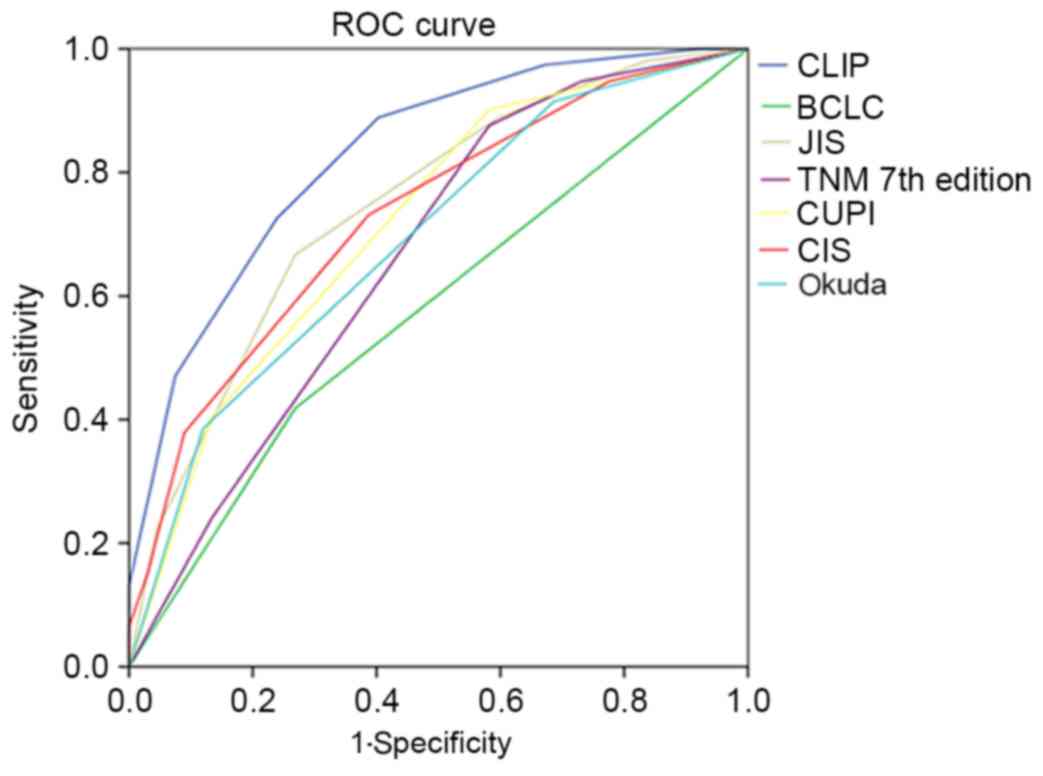|
1
|
Torre LA, Bray F, Siegel RL, Ferlay J,
Lortet-Tieulent J and Jemal A: Global cancer statistics, 2012. CA
Cancer J Clin. 65:87–108. 2015. View Article : Google Scholar : PubMed/NCBI
|
|
2
|
Chen W, Zheng R, Baade PD, Zhang S, Zeng
H, Bray F, Jemal A, Yu XQ and He J: Cancer statistics in China,
2015. CA Cancer J Clin. 66:115–132. 2016. View Article : Google Scholar : PubMed/NCBI
|
|
3
|
Lai CL, Ratziu V, Yuen MF and Poynard T:
Viral hepatitis B. Lancet. 362:2089–2094. 2003. View Article : Google Scholar : PubMed/NCBI
|
|
4
|
Llovet JM, Ricci S, Mazzaferro V, Hilgard
P, Gane E, Blanc JF, De Oliveira AC, Sanoro A, Raoul JL, Forner A,
et al: Sorafenib in advanced hepatocellular carcinoma. N Engl J
Med. 359:378–390. 2008. View Article : Google Scholar : PubMed/NCBI
|
|
5
|
Cheng AL, Kang YK, Chen Z, Tsao CJ, Qin S,
Kim JS, Luo R, Feng J, Ye S, Yang TS, et al: Efficacy and safety of
sorafenib in patients in the Asia-Pacific region with advanced
hepatocellular carcinoma: A phase III randomised, double-blind,
placebo controlled trial. Lancet Oncol. 10:25–34. 2009. View Article : Google Scholar : PubMed/NCBI
|
|
6
|
Bruix J, Gores GJ and Mazzaferro V:
Hepatocellular carcinoma: Clinical frontiers and perspectives. Gut.
63:844–855. 2014. View Article : Google Scholar : PubMed/NCBI
|
|
7
|
Bertino G, Demma S, Ardiri A, Proiti M,
Gruttadauria S, Toro A, Malaguarnera G, Bertino N, Malaguarnera M,
Malaguarnera M and Di Carlo I: Hepatocellular carcinoma: Novel
molecular targets in carcinogenesis for future therapies. Biomed
Res Int. 2014:2036932014. View Article : Google Scholar : PubMed/NCBI
|
|
8
|
Abou-Alfa GK: Selection of patients with
hepatocellular carcinoma for sorafenib. J Natl Compr Canc Netw.
7:397–403. 2009. View Article : Google Scholar : PubMed/NCBI
|
|
9
|
Abou-Alfa GK: Hepatocellular carcinoma:
Molecular biology and therapy. Semin Oncol. 33 6 Suppl 11:S79–S83.
2006. View Article : Google Scholar : PubMed/NCBI
|
|
10
|
Llovet JM and Bruix J: Prospective
validation of the cancer of the liver Italian program (CLIP) score:
A new prognostic system for patients with cirrhosis and
hepatocellular carcinoma. Hepatology. 32:679–680. 2000. View Article : Google Scholar : PubMed/NCBI
|
|
11
|
Kubo S, Tanaka H, Shuto T, Takemura S,
Yamamoto T, Uenishi T, Tanaka S, Hai S, Yamamoto S, Ichikawa T, et
al: Prognostic effects of causative virus in hepatocellular
carcinoma according to the Japan integrated staging (JIS) score. J
Gastroenterol. 40:972–979. 2005. View Article : Google Scholar : PubMed/NCBI
|
|
12
|
DeLong ER, DeLong DM and Clarke-Pearson
DL: Comparing the areas under two or more correlated reciever
operating characteristic curves: A nonparamentric approach.
Biometrics. 44:837–845. 1988. View
Article : Google Scholar : PubMed/NCBI
|
|
13
|
Zhang JF, Shu ZJ, Xie CY, Li Q, Jin XH, Gu
W, Jiang FJ and Ling CQ: Prognosis of unresectable hepatocellular
carcinoma: Comparison of seven staging systems (TNM, Okuda, BCLC,
CLIP, CUPI, JIS, CIS) in a Chinese cohort. PLoS One. 9:e881822014.
View Article : Google Scholar : PubMed/NCBI
|
|
14
|
Zhang BH, Wang XH, Yue HY and Ling CQ: A
new staging system is more discriminant than conventional staging
systems for unresectable hepatocellular carcinoma. J Cancer Res
Clin Oncol. 136:821–827. 2010. View Article : Google Scholar : PubMed/NCBI
|
|
15
|
Adhoute X, Penaranda G, Raoul JL, Le Treut
P, Bollon E, Hardwigsen J, Castellani P, Perrier H and Bourlière M:
Usefulness of staging systems and prognostic scores for
hepatocellular carcinoma treatments. World J Hepatol. 8:703–715.
2016. View Article : Google Scholar : PubMed/NCBI
|
|
16
|
Yau T, Yao TJ, Chan P, Ng K, Fan ST and
Poon RT: A new prognostic score system in patients with advanced
hepatocellular carcinoma not amendable to locoregional therapy:
Implication for patient selection in systemic therapy trials.
Cancer. 113:2742–2751. 2008. View Article : Google Scholar : PubMed/NCBI
|
|
17
|
Bruix J and Sherman M; Practice Guidelines
Committee, American Association for the Study of Liver Diseases, :
Management of hepatocellular carcinoma. Hepatology. 42:1208–1236.
2005. View Article : Google Scholar : PubMed/NCBI
|
|
18
|
Oken MM, Creech RH, Tormey DC, Horton J,
Davis TE, McFadden ET and Carbone PP: Toxicity and response
criteria of the eastern cooperative oncology group. Am J Clin
Oncol. 5:649–655. 1982. View Article : Google Scholar : PubMed/NCBI
|
|
19
|
[Guideline] National Comprehensive Cancer
Network, . NCCN Hepatobiliary Cancers Clinical Practice Guidelines
in Oncology. http://www.nccn.org/professionals/physician_gls/pdf/hepatobiliary.pdfVersion
2. 2016
|
|
20
|
Tabrizian P, Roayaie S and Schwartz ME:
Current management of hepatocellular carcinoma. World J
Gastroenterol. 20:10223–10237. 2014. View Article : Google Scholar : PubMed/NCBI
|
|
21
|
Maida M, Orlando E, Cammà C and Cabibbo G:
Staging systems of hepatocellular carcinoma: A review of
literature. World J Gastroenterol. 20:4141–4150. 2014. View Article : Google Scholar : PubMed/NCBI
|
|
22
|
Huang YH, Chen CH, Chang TT, Chen SC, Wang
SY, Lee HS, Lin PW, Huang GT, Sheu JC, Tsai HM, et al: Evaluation
of predictive value of CLIP Okuda, TNM and JIS staging systems for
hepatocellular carcinoma patients undergoing surgery. J
Gastroenterol Hepatol. 20:765–771. 2005. View Article : Google Scholar : PubMed/NCBI
|
|
23
|
Huitzil-Melendez FD, Capanu M, O'Reilly
EM, Duffy A, Gansukh B, Saltz LL and Abou-Alfa GK: Advanced
hepatocellular carcinoma: Which staging systems best predict
prognosis? J Clin Oncol. 28:2889–2895. 2010. View Article : Google Scholar : PubMed/NCBI
|
|
24
|
Kudo M, Chung H, Haji S, Osaki Y, Oka H,
Seki T, Kasugai H, Sasaki Y and Matsunaga T: Validation of a new
prognostic staging system for hepatocellular carcinoma: The JIS
score compared with the CLIP score. Hepatology. 40:1396–1405. 2004.
View Article : Google Scholar : PubMed/NCBI
|
|
25
|
Nishikawa H, Kita R, Kimura T, Endo M,
Ohara Y, Sakamoto A, Saito S, Nishijima N, Nasu A, Komekado H and
Osaki Y: Proposal of the performance status combined Japan
Integrated Staging system in hepatocellular carcinoma complicated
with cirrhosis. Int J Oncol. 46:2371–2379. 2015.PubMed/NCBI
|
|
26
|
Yen YH, Changchien CS, Wang JH, Kee KM,
Hung CH, Hu TH, Lee CM, Lin CY, Wang CC, Chen TY, et al: A modified
TNM-based Japan Integrated Score combined with AFP level may serve
as a better staging system for early-stage predominant
hepatocellular carcinoma patients. Dig Liver Dis. 41:431–441. 2009.
View Article : Google Scholar : PubMed/NCBI
|
|
27
|
Qin LX and Tang ZY: The prognostic
significance of clinical and pathological features in
hepatocellular carcinoma. World J Gastroenterol. 8:193–199.
2002.PubMed/NCBI
|
|
28
|
Toyoda H, Kumada T, Osaki Y, Oka H, Urano
F, Kudo M and Matsunaga T: Staging hepatocellular carcinoma by a
novel scoring system (BALAD score) based on serum markers. Clin
Gastroenterol Hepatol. 4:1528–1536. 2006. View Article : Google Scholar : PubMed/NCBI
|
|
29
|
Ji Y, Li B, Zhu Z, Guo X, He W, Fan Z and
Zhang W: Overexpression of WAVE3 promotes tumor invasiveness and
confers an unfavorable prognosis in human hepatocellular carcinoma.
Biomed Pharmacother. 69:409–415. 2015. View Article : Google Scholar : PubMed/NCBI
|
|
30
|
Hashimoto R, Kanda M, Takami H, Shimizu D,
Oya H, Hibino S, Okamura Y, Yamada S, Fujii T, Nakayama G, et al:
Aberrant expression of melanoma-associated antigen-D2 serves as a
prognostic indicator of hepatocellular carcinoma outcome following
curative hepatectomy. Oncol Lett. 9:1201–1206. 2015.PubMed/NCBI
|
|
31
|
Yuan SG, Liao WJ, Yang JJ, Huang GJ and
Huang ZQ: DEP domain containing 1 is a novel diagnostic marker and
prognostic predictor for hepatocellular carcinoma. Asian Pac J
Cancer Prev. 15:10917–10922. 2014. View Article : Google Scholar : PubMed/NCBI
|
|
32
|
Zhen L, Shijie N and Shuijun Z: Tumor PHD2
expression is correlated with clinical features and prognosis of
patients with HCC receiving liver resection. Medicine (Baltimore).
93:e1792014. View Article : Google Scholar : PubMed/NCBI
|
|
33
|
Cai L and Cai X: Up-regulation of miR-9
expression predicate advanced clinicopathological features and poor
prognosis in patients with hepatocellular carcinoma. Diagn Pathol.
9:10002014. View Article : Google Scholar : PubMed/NCBI
|
|
34
|
Meng FL, Wang W and Jia WD: Diagnostic and
prognostic significance of serum miR-24-3p in HBV-related
hepatocellular carcinoma. Med Oncol. 31:1772014. View Article : Google Scholar : PubMed/NCBI
|
|
35
|
Heo MJ, Kim YM, Koo JH, Yang YM, An J, Lee
SK, Lee SJ, Kim KM, Park JW and Kim SG: microRNA-148a dysregulation
discriminates poor prognosis of hepatocellular carcinoma in
association with USP4 overexpression. Oncotarget. 5:2792–2806.
2014. View Article : Google Scholar : PubMed/NCBI
|
|
36
|
Govaere O, Komuta M, Berkers J, Spee B,
Janssen C, De Luca F, Katoonizadeh A, Wouters J, van Kempen LC,
Durnez A, et al: Keratin 19: A key role player in the invasion of
human hepatocellular carcinomas. Gut. 63:674–685. 2014. View Article : Google Scholar : PubMed/NCBI
|
|
37
|
Kaseb AO, Hassan MM, Lin E, Xiao L, Kumar
V, Pathak P, Lozano R, Rashid A, Abbruzzese JL and Morris JS:
V-CLIP: Integrating plasma vascular endothelial growth factor into
a new scoring system to stratify patients with advanced
hepatocellular carcinoma for clinical trials. Cancer.
117:2478–2488. 2011. View Article : Google Scholar : PubMed/NCBI
|
|
38
|
Nault JC, De Reyniès A, Villanueva A,
Calderaro J, Rebouissou S, Couchy G, Decaens T, Franco D, Imbeaud
S, Rousseau F, et al: A hepatocellular carcinoma 5-gene score
associated with survival of patients after liver resection.
Gastroenterology. 145:176–187. 2013. View Article : Google Scholar : PubMed/NCBI
|















